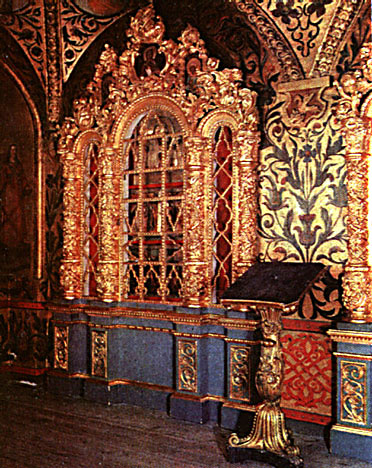| |
The major construction work that took place
in the Kremlin in the 17th century was the rebuilding of the Terem Palace
(Tsarskie Terema). On the foundations of the old palace of 1499, Russian
builders Bazhen Ogurtsov, Antipa Konstantinov, Larion Ushakov and Trofim
Sharutin in 1635-1636 erected a three-story palace as living quarters for the
Tsar and his family. In the absence of experience or a model, the builders
constructed the brick palace as if it had been made of wood, that is, with
several interconnected rectangular block work units resembling "Srub
Kletei," put side by side to make one floor, stacked one on top of the
other to form several stories. Rooms of all floors are of the same rather small
size and all have three windows, the same as any peasant izba. The exception is
the top floor, which has just one large room - the tradtional Terem, a feature
borrowed from the wooden "Khoromi" - or Russian wooden mansions. This
top room was named "The Little Golden Terem," which in turn gave its
name to the entire palace. "Terem" is a Tatar word for the upper
room, a sort of a belvedere, usually reserved for women, where men, except
husbands and close relatives, were not permitted. This rigid isolation of women
is one of the customs that Russians inherited from the Tatars and practiced for
several centuries. Though renovated several times, the rooms where Tsar Aleksei
lived preserve all the basic decorative elements of his time. Portals, window
architraves, entablatures, architraves and the edges of the vaults are all of
carved white stone, in floral and foliage designs, intermixed with birds,
beasts and masks, painted over with bright colors. The exterior sides of the
windows were decorated similarly. In each room there is a big beautiful faience
stove. The entrance to the Terem Palace is from the Verkhospaskaya Terrace
(Verkhospaskaya Ploshchadka), now covered which connects through the Golden
Archway (Zolotoe Kryltso) and a staircase to the Hall of Saint Vladimir in the
Grand Kremlin Palace.
The Golden Gate is a very fine piece of craftsmanship. It was hammered by
Skilled Russian blacksmiths in 1670 into an object of great artistic value.
Because it was finished a few years after the Copper revolt, which occurred
when a financial panic caused many to exchange their copper coins for silver,
and then the silver again for copper, legend says that the Gate was cast from
copper coins. In fact it is made of gold-plated wrought iron.
The Tsar's private quarters contained several rooms. The first was known as
Waiting room (Tapesnaya), where boyars seeking audience waited for the Tsar to
see them or receive them in the next room. It also served as a dining room. The
second became known as the Room of the Cross (Krestovaya or Gostinaya) and
served for the Tsar to meet the boyar council and occasionally to receive
foreign ambassadors and dignitaries. It was in this room in 1666 that the
Church council met to try Nikon. The third was the Throne Room (Prestolnaya or
Tronnaya) which served as the Tsar's study, where only the most privileged were
permitted t enter. The middle window of this room was known as
the"Beautiful" or "The Window of Supplication," (The
Chelobitnoe Okno). Indeed the exterior of this window was even more
heavily ornamented than the others. With the help of a special device a small
chest could be lowered through this window to the ground, where the poor and
those with grievances could place their petitions and supplications addressed
directly to the Tsar. The fourth room was the Tsar's bedroom
(Opochivalnaya), and the fifth his private oratory (molelnaya),
with a pulpit and two beautiful alcoves decorated with gold, where he kept his
icons, crosses and bibles. The private quarters of the Tsar were repainted and
renovated in 1836-1849 by Fedor G. Solntsev, assisted by Kisselev and
Gherasimov. Though only fragments remain of the paintings and decorations done
by Simon Ushakov, the Terem Palace gives us quite a complete picture of the way
in which Russian tsars lived in the 17th century.
Here we have one view inside the Terem. For more views please go to
Terem. And don't forget to go to the section on
Moscow for many more views of the
kremlin and more on the Terem as well.
|
|


